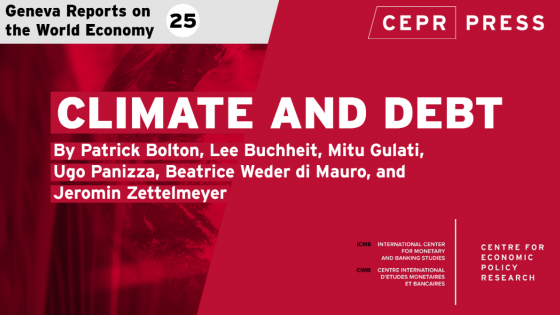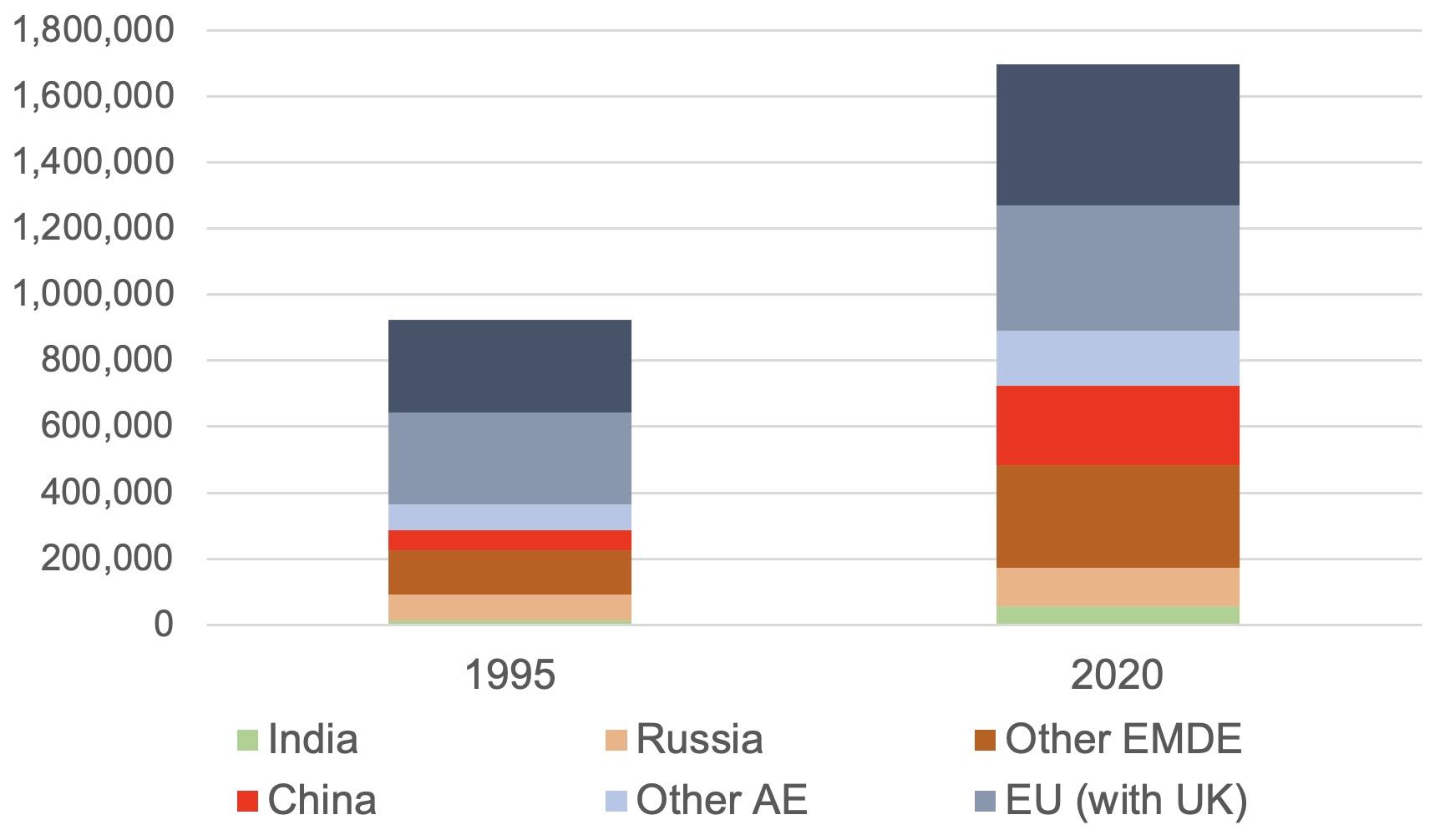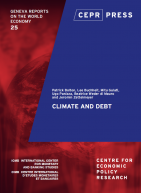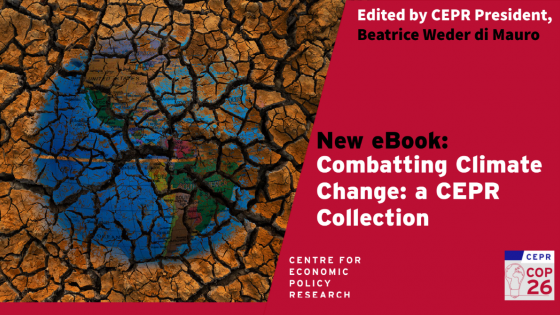When discussing the links between climate change and debt, there are 4 numbers to bear in mind: 40, 300, 2,400, and 60:
- 40 gigatonnes (Gt) refers to the current yearly global emissions of CO2 from fossil fuel and industry.
They constitute the largest part of greenhouse gases (GHGs) and have continued to grow year after year.
- 300 Gt is the remaining carbon budget if the goal of keeping average temperature rise to below 1.5°C is to be reached with high likelihood. The idea of a carbon budget highlights the fact that climate change is a stock and not a flow problem: each molecule of additional CO2 emitted stays in the atmosphere for a very long time and thickens the concentration of the layer of gases that create the greenhouse effect. At current emission levels, the carbon budget will be exhausted in less than eight years.
- 2,400 is the amount of cumulative historical emissions since 1850. It is a measure of the historical burden linked to the amount of CO2 which is in the atmosphere and that is already warming the earth by about 1°C over pre-industrial levels.
- 60% is the share of low-income economies that are classified by the IMF and the World Bank as being either in debt distress or at high risk of debt distress.
Mitigating and adapting to climate change is both a matter of survival (e.g. Burzyński et al. 2019) and of economic rationality (e.g. Furman et al. 2015). Investing in mitigation and adaptation will reduce the economic costs of climate change. In that sense, it saves money. But compared to an alternate universe in which climate change does not exist, mitigation and adaptation will be expensive.
Debt is needed to distribute the burden of climate action across generations. Even in a one-country world, the link between climate and debt leads to complicated questions: How much debt creation does climate action justify? Can climate sustainability and debt sustainability be reconciled? And how should debt instruments be designed to best support climate change?
However, the planet consists of many countries, each with its own interests and resource limitations. This creates an additional challenge related to aligning individual country interests with the global interest of limiting temperature rises.
The 25th Geneva Report on the World Economy discusses these challenges by focusing attention on how climate mitigation and adaptation is paid for, and who pays for it (Bolton et al. 2022). This requires thinking about instruments such as sovereign bonds, carbon credits, conditional official grants, and debt relief from both public and private sources. The report points out that cross-country transfers are essential to effectively address climate change, for two reasons.
First, country-level actions can create global externalities. While a relatively small number of countries are responsible for 90% of total GHG emissions, several countries do not emit much CO2 because they are poor. If these countries grow by adopting the same brown technology adopted by today’s large emitters, they will become themselves large emitters. It is thus key that these countries leapfrog to greener technologies.
Second, many countries that are most affected by climate change both require and deserve external fiscal support for adapting to (and hence protecting themselves from) climate change. Given limited fiscal space, many countries will require external support (transfers, not just loans) to undertake these investments. Since the benefits of adaptation are mostly local, there is no clear efficiency argument for such support. Yet, cross-country transfers are justified on fairness grounds. Besides being poor, the countries with the greatest adaptation needs are generally not responsible for most of the stock or CO2 that is causing climate change. The advanced economies have thus a moral responsibility towards poorer countries that suffer from the consequences of climate change. Moreover, there is a close relationship between emissions per capita and income per capita. It therefore seems fair that richer countries should make a greater effort in reducing emissions and in compensating poorer countries that suffer the negative effect of climate change.
Figure 1 Cumulated carbon emissions
After describing the essential objectives of climate-related policies and the fiscal constraints that policymakers operate under when seeking to meet these objectives, the report describes the potential role of green sovereign bonds and sustainability-linked bonds. While such instruments could both increase fiscal space and provide incentives for climate action, we show that green bonds do not seem to enjoy a significant ‘greenium’ (borrowing cost advantage), possibly because none of the currently issued sovereign or quasi-sovereign green bonds includes enforceable climate commitments. The report also discusses the role of carbon offsets. It shows that for now, a deep global carbon credit market is still largely a promise and that delivering on this promise requires institutional foundations as solid as the most sophisticated stock exchanges in the world. Finally, the report asks how best to deliver external fiscal support for climate investment in high-debt developing countries. It compares conditional grants, debt-climate swaps, and comprehensive debt restructuring and concludes that conditional grants generally work best, but there are conditions under which debt–climate swaps are also desirable.
The report concludes that no single instrument is right for all countries or at all times. Instead, it is essential to deploy multiple instruments and actions bearing in mind their limitations and potential trade-offs among them. We summarise these instruments and actions with six main proposals and policy recommendations that focus on financial instruments as a means of incentivising and committing governments to do the right thing and providing fiscal space for climate investment in countries that could not otherwise afford it:
- Develop a clear legal framework and verification mechanisms which will enhance the credibility of green sovereign bonds. The current state of green bonds, we worry, might not be resulting in anything meaningful because they promise little or nothing that would be legally enforceable. There is thus the risk that the market for green sovereign bonds will end up in a situation where asset managers pretend that they are buying green bonds and issuers pretend that they are doing green things with the funds. We suggest addressing this issue by developing bonds with concrete and legally enforceable green promises and describe the key elements that should be included in such genuine green bonds.
- Set up a climate information and monitoring system to support the development of sustainability-linked sovereign bonds. Use of proceeds requirements associated with green bonds can be difficult to both implement and verify. Moreover, by detailing specific types of expenditure or projects, traditional green bonds do not allow for experimentation or innovation. Sustainability-linked bonds contingent on attaining prespecified environmental targets rather than on dictating expenditures on specific projects are more flexible and incentive-compatible. Multilateral development banks and NGOs can help develop the sustainability-linked bond market by contributing to their design and by monitoring performance indicators.
- Create an institutional framework for a carbon credit market based on mandatory direct and indirect carbon emission reduction requirements for all large emitters. While most emissions stem from rich countries, carbon sinks tend to be concentrated in poorer countries with limited debt-carrying capacity. While there have been efforts to build mechanisms to compensate these countries for maintaining or expanding their carbon sinks, the financial compensation countries have received through these programmes remains small. A well-working global carbon market could generate substantial flows from rich to poor countries and help monetise the natural assets that these countries hold. However, this will not happen as long as the market for carbon credit remains fragmented and voluntary. Two sets of actions are required to achieve the needed scale: (1) mandatory direct and indirect CO2e emission reduction requirements for all large emitters; and (2) the creation of a comprehensive monitoring and certification infrastructure, the standardisation of carbon credits, and a registry of traded carbon credits.
- Commit to an annual target for fiscal support for adaptation, mitigation, and transition expenditures in developing and emerging market countries. Public investment costs for adaptation in emerging markets and developing countries are estimated to be in the order of US$500 billion per year. Advanced and high-emitting upper-middle-income countries will need to provide fiscal support at least for the countries whose mitigation and adaptation costs exceed their fiscal capacity; and they should go beyond this minimum on fairness grounds.
- Improve the design of debt-for-nature swaps. Debt–nature swaps could be linked to budgetary spending categories or climate performance commitments that allow for greater scale with respect to the case in which swaps are linked to individual projects. To maximise fiscal space, debt–nature swaps should avoid debtor-conducted buybacks in secondary markets, and instead rely either on negotiated debt exchange offers backed by collective action clauses or donor-conducted debt buybacks. The structure of debt nature swaps should seek to ensure that climate or conservation-related expenditure commitments are honoured even if the debtor is forced to restructure its commercial debt.
- Include climate conditionality in comprehensive debt restructurings addressing unsustainable debt. Future debt restructurings should be based on debt sustainability analyses that explicitly accounts for the fiscal costs of climate-related expenditures and include enforceable climate conditionality. One way to achieve this objective is by exchanging the conventional bonds that are being restructured with appropriately defined sustainability-linked bonds.
Making these policies happen require substantial political will not only in the richer countries that have benefitted from brown development and created the problem, but also in the developing countries that must commit not to repeat these mistakes. Both sides must rise to the challenge of supporting a fair and rapid transition to a net zero economy.
References
Burzyński, M, J de Melo, C and F Docquier (2019), “Climate migration frightens... climate poverty is frightening!”, 10 December.
Furman, J, R Shadbegian and J Stock (2015), “The cost of delaying action to stem climate change: A meta-analysis”, 25 February.
Bolton, P, L Buchheit, M Gulati, U Panizza, B Weder di Mauro and J Zettelmeyer (2022), Climate and Debt, Geneva Reports on the World Economy 25, ICMB and CEPR.











